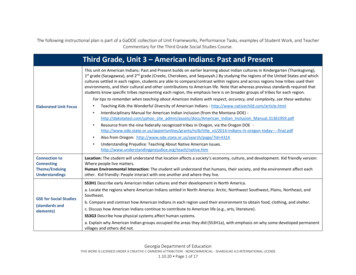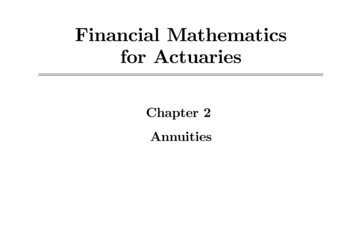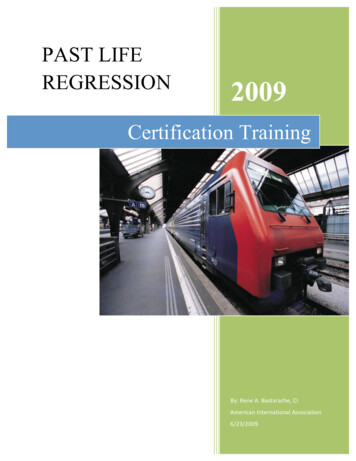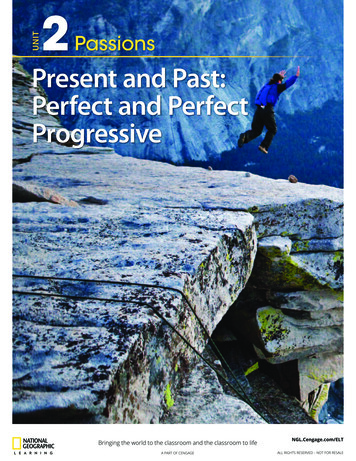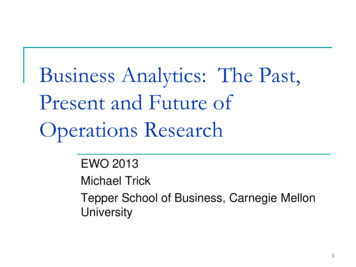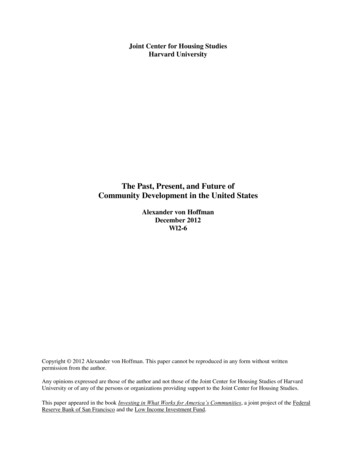
Transcription
Joint Center for Housing StudiesHarvard UniversityThe Past, Present, and Future ofCommunity Development in the United StatesAlexander von HoffmanDecember 2012Wl2-6Copyright 2012 Alexander von Hoffman. This paper cannot be reproduced in any form without writtenpermission from the author.Any opinions expressed are those of the author and not those of the Joint Center for Housing Studies of HarvardUniversity or of any of the persons or organizations providing support to the Joint Center for Housing Studies.This paper appeared in the book Investing in What Works for America’s Communities, a joint project of the FederalReserve Bank of San Francisco and the Low Income Investment Fund.
The Past, Present, andFuture of CommunityDevelopment in theUnited StatesAlexander von Hoffman1Harvard UniversityFor more than a century, American reformers havestruggled to remedy the problems of poverty in theplaces where low-income people live. At first, thesesocial improvers could muster only a few isolated solutions, but by the end of the twentieth century, they hadexpanded their efforts to a large, dynamic, and sophisticated fieldof action. Today thousands of nonprofit community developmentorganizations operate in the poorest urban and rural areas of thecountry. More impressively, they have helped stabilize community life and help individuals and families in some of the mostforsaken neighborhoods in the country. The South Bronx, once1 “The Past, Present, and Future of Community Development in the United States.” Copyright 2012 Alexander von Hoffman. This article cannot be reproduced in any form withoutwritten permission from Alexander von Hoffman. Permission requests should be sent toalexander von hoffman@harvard.edu.10Investing in What Works for America’s Communities
the most infamous slum district in the United States, has becomelivable and vibrant.To build a decentralized system of neighborhood improvementand individual betterment was not easy. The community development field had to emerge from the shadow of the top-downapproach embodied in the urban renewal and public housingbureaucracies. The antipoverty crusaders realized that they had tocombine a passion for social justice with viable management andbusiness practices. They learned to keep practitioners accountablefor their work and to measure their accomplishments.And the movement’s leaders had to grow and change, which theydid by adopting new strategies aimed at building up the financesand assets of individuals, as opposed to simply looking at theproblems of places.To keep a decentralized system viable, of course, costs money.The current community development world could flourishonly when new financial institutions along with philanthropicorganizations, and especially government, offered sufficientfinancial support.From the beginning, community development advocates havepursued the vision of a truly comprehensive strategy, one thatwould integrate approaches and overcome the barriers betweentypes of services and the government and nongovernment entitiesthat provide them. Now, in the twenty-first century, the vision ofbroadly collaborative approaches seems more feasible than at anytime in the long and rich history of community development.And yet to fulfill this vision the community development fieldmust overcome the worst economic and financial circumstancesits supporters have faced in the last 25 years.Community Development: the Early DaysTo Fight the SlumsThe concept of community development originated in thelate nineteenth century when reformers discovered America’sCommunity Development: Past and Present11
“backward” areas. Socially committed women and men inSettlement Houses and charitable organizations confronted theills of industrial capitalism: poorly paid immigrant and racialminority wage workers crowded into tenement apartments,cottages, and shacks in seedy neighborhoods near docks, trains,and factories. During the Progressive Era of the early twentiethcentury, urban reformers connected poverty, overcrowding,crime, youth delinquency, and sundry other social ills to theunsanitary and unsightly slums where the working poor andindigents lived.The sweeping Progressive agenda of political, social, and physicalreform anticipated later comprehensive antipoverty strategies.The women who led many of the reform movements liked to callthe totality of their efforts “municipal housekeeping.” Otherstalked of dealing with “the social question,” and historians laterlabeled it progressivism. But under any name, their wide-rangingattack on the evils of modern urban society embraced a welterof labor, education, and welfare measures, including attemptsto improve the lives of the lower classes through better housing.But if Progressive reformers left the useful legacy of trying tocounter the many aspects of poverty, they also handed down theless useful principle that outside experts would save society byimposing reforms on the people they were trying to help.New Deal Community Building: Comprehensive but Top-DownFor the most part the Progressive reformers agitated in local andstate government until the 1930s when the Great Depression andthe election of Franklin D. Roosevelt gave outlets for their socialprograms in the federal government. True to its Progressive roots,Roosevelt’s New Deal encompassed a remarkably wide array ofreforms, both visionary and practical. At times it seemed that hecreated a new agency to solve each individual social problem.The idea of comprehensive physical and social planning ranthrough the diverse array of New Deal community developmentprograms. At the large scale, the Roosevelt administrationstrove to develop rural regions, most notably through theTennessee Valley Authority, which built electric power dams,12Investing in What Works for America’s Communities
taught new agricultural methods, and planned new towns inthe impoverished Tennessee River basin. At the local level inAmerica’s cities and rural counties, New Dealers rebuilt slumswith public housing projects, which they designed as smallplanned communities.Although New Deal programs were idealistic and wellintentioned, their top-down administrative structure wasundemocratic. Like their Progressive forebears, the New Dealersbelieved that enlightened experts such as themselves shoulddictate the terms of the bright shining new world they wouldcreate. Although they would work with leaders of labor, religious, and racial organizations, the reformers in the 1930s forthe most part failed to include ordinary people in their decisionmaking process.The defect of this approach appeared early in the history ofthe public housing program in the form of the “neighborhoodcomposition” rule. Responding to requests from field officers fora rule for selecting tenants for housing projects in racially mixedneighborhoods, Secretary of the Interior Harold Ickes set downthe guideline that members of whichever race had predominatedprior to demolition of the slums would be the only group to beadmitted. This segregation policy would hamper the program fordecades to come.The Slum Returns as the GhettoWorld War II brought great changes to America’s cities. Theconstruction of rapid transit systems and the Depression had indifferent ways helped decongest the densely packed immigrantcity neighborhoods, but now the inner city filled up again. Theboom in wartime industrial jobs started a migration of AfricanAmericans and people from other racial minorities in search ofeconomic opportunity that lasted into the Cold War. But racismin white neighborhoods, real estate practices, and federal government policies combined with the newcomers’ relatively lowincomes to keep increasing numbers of blacks locked into racialghettos. Soon crowded homes and decrepit buildings like thosethat had horrified reformers at the turn of the century were back.Community Development: Past and Present13
Despite obvious racial issues—whites in Chicago, Detroit, andother large cities rioted and violently assaulted blacks whomoved into their neighborhoods—and growing welfare needs,mid-twentieth century political leaders and reformers saw onlyphysical problems. With little regard for the social dimension,they fixated on slum clearance as a remedy for the cities’ socialand economic problems.2Doubling Down on Top-DownThe Housing Act of 1949 inaugurated a new federal program,urban redevelopment, later known as urban renewal, in which agovernment agency staffed by experts took “blighted and slumareas” by eminent domain, demolished the buildings therein,and turned the properties over to private developers to rebuild.Realtors and urban planners had devised urban redevelopment asa way to staunch the departure of the upper middle class to thesuburbs and stop physical and economic deterioration. Needlessto say, this top-down program had no mechanism for consultingthose whose businesses and homes were to be taken. Within afew years, civil rights advocates, angered at the demolition ofmassive numbers of African American homes, would deride theprogram as “Negro removal.” Yet the urban renewal projectsthat destroyed the predominantly white working-class West Endin Boston to build luxury high-rise apartment buildings and razedthe Mexican-American Chavez Ravine neighborhood in LosAngeles for a professional baseball stadium shamefully demonstrated that the program laid waste to low-income communitiesof other ethnic backgrounds as well.The 1949 Housing Act also revived the public housing program,on hiatus during the war, with a fresh round of authorizations. The downtown powers of American cities—the mayors,businessmen, and civic leaders—thought public housing would2 Robert C. Weaver, The Negro Ghetto (New York: Harcourt, Brace, 1948); CharlesAbrams, Forbidden Neighbors: A Story of Prejudice in Housing (New York: Harperand Brothers, 1955); Arnold Hirsch, Making the Second Ghetto: Race and Housing inChicago, 1940–1960 (Cambridge: Cambridge University Press, 1983); Thomas Sugrue, TheOrigins of the Urban Crisis: Race and Inequality in Postwar Detroit (Princeton: PrincetonUniversity Press, 1996).14Investing in What Works for America’s Communities
kill two birds with one stone: clear the awful-looking slums andprovide upwardly mobile African Americans with a new lot inlife. They overlooked that public housing only provided for afraction of the houses that were demolished, and they hardly everthought about helping the displaced find new homes. Worse,during the 1950s, big-city officials built modernist public housingtowers in racial ghettos to keep African Americans from movingto white neighborhoods, perpetuating the program’s tradition ofracial segregation. The U.S. Interstate highway program, enactedin 1956, probably demolished more low-income neighborhoods,if it were possible, than either urban renewal or public housing.3If the purpose of these postwar programs was to contain thepoor and stop the spread of blight, they failed completely, largelybecause the destruction simply forced those low-income familieswho lost their homes to move to new areas.The Rediscovery of PovertyThe Other AmericaStarting about the mid-1950s, observers of American cities beganto sound increasingly anxious. At first, many believed that urbanproblems stemmed primarily from the breakdown of physicalplanning and government services. In 1957, Fortune magazineproduced a special issue, later a book, of essays that detailed theeffects of the car, city government, the slums, sprawl, and, in JaneJacobs’ provocative debut of her urban theories, the failure torevive downtown. As more neighborhoods turned into lowincome minority communities, social problems, particularly theold issue of “juvenile delinquency,” entered the discussion aboutcities. From films like The Blackboard Jungle to West Side Story,America’s popular culture gave iconic form to the urban streetgangs and by extension the neighborhoods in which they lived.3 Alexander von Hoffman, “A Study in Contradictions: The Origins and Legacy of theHousing Act of 1949,” Housing Policy Debate, 10 (3) (Summer 2000): 299–326; Hirsch,Making the Second Ghetto; Raymond A. Mohl, "Race and Space in the Modern City:Interstate-95 and the Black Community in Miami." In Urban Policy in Twentieth-CenturyAmerica, edited by Arnold R. Hirsch and Raymond A. Mohl (New Brunswick, NJ: RutgersUniversity Press, 1993), pp. 100–158; “The Interstates and the Cities: Highways, Housingand the Freeway Revolt.” Research Report (Washington, DC: Poverty and Race ResearchAction Council, 2002), pp. 30–38.Community Development: Past and Present15
Nonetheless, the increasing affluence of Americans made itshocking to discover that grinding poverty persisted. In 1962,Michael Harrington published a searing portrait of deprived andinvisible poor people in The Other America, a book that caughtthe attention of many of the nation’s leaders, including PresidentJohn F. Kennedy. The dawning realization of poverty in the midstof plenty gave rise to a new generation of wide-ranging efforts tofight urban and rural social problems.As in the past and many times since, reformers realized thatsolving the problems of the poor depended on coordinating avariety of efforts for economic development and human development. In 1958, two members of the faculty of the ColumbiaSchool of Social Work, Richard Cloward and Lloyd Ohlin,started Mobilization for Youth to combat juvenile delinquencyon Manhattan’s Lower East Side. Cloward and Ohlin blamedslum conditions and racial discrimination for juvenile delinquency and in response set up Mobilization for Youth as abroad attack—including job training, mental health counseling,and educational programs—on neighborhood social conditions.Although Mobilization for Youth succeeded in galvanizinglow-income residents to act on their own behalf, school officials,welfare workers, and other professionals became defensive. Manyof the efforts broke down in mutual hostility.In 1961, Paul Ylvisaker, an officer of the Ford Foundationconcerned with urban and racial issues, started the Gray Areasprograms in Boston, Oakland, New Haven, Philadelphia, andWashington, DC. With grants from the Ford Foundation tolocal school departments, governments, and nonprofit agencies,he hoped to reform the delivery of social services to respondin innovative ways to the needs of the residents of low-incomeracial minority neighborhoods. The engine of this experiment incomprehensive community development was to be a nonprofitagency. Although these trials gave form to approaches that wouldsoon resurface in federal policy, the failure of Ylvisaker andhis foundation colleagues to think through ways to coordinatedisparate agencies or to allow low-income African Americans to16Investing in What Works for America’s Communities
participate meaningfully in planning the improvement of theirneighborhoods undermined the Gray Areas projects.4LBJ Declares a Comprehensive War on PovertyThe Kennedy administration responded to the growing senseof urgency about American poverty. Attorney General RobertKennedy nurtured youth programs through the President’sCommittee on Juvenile Delinquency, most famously HarlemYouth Opportunities Unlimited (HARYOU) in New YorkCity, formed in 1962. Just days before he was assassinated,President Kennedy approved plans to launch a trial program asan attack on poverty in America. Soon after succeeding to thepresidency, Lyndon B. Johnson raised the stakes by declaringnot an attack but a full-fledged War on Poverty. In August 1964,Congress passed the Economic Opportunity Act, and Johnsonnamed Sargent Shriver to head the ambitious new agency thatwould carry it out.As implemented by Shriver, the War on Poverty reflected the antipoverty experiments but with an even wider scope. In the Officeof Economic Opportunity (OEO) and subsequent programs suchas Model Cities, the Johnson administration strove for systematicapproaches to help Americans lift themselves out of poverty.Through “comprehensive community action programs,” Johnsondeclared in signing the Economic Opportunity Act, “We willstrike at poverty's roots.” He reeled off numerous approaches,including remedial education, job training, health and employment counseling, and neighborhood improvement. In thefollowing years, the administration would add more educationand human development elements: preschool learning throughHead Start, itself a comprehensive approach that was to provide“health, educational, nutritional, social, and other services” to4 Robert Halpern, Rebuilding the Inner City: A History of Neighborhood Initiatives toAddress Poverty in the United States (New York: Columbia University Press, 1995),pp. 89–101; G. William Domhoff, “The Ford Foundation in the Inner City: Forging anAlliance with Neighborhood Activists” (Santa Cruz, CA: University of Southern California,WhoRulesAmerica.net, 2005), available at http://www2.ucsc.edu/whorulesamerica/local/ford foundation.html.Community Development: Past and Present17
low-income children and their families; food stamps; UpwardBound for college preparation; and the child nutrition program.The idea of comprehensiveness permeated the antipovertymeasures of the 1960s. To coordinate the federal government’smultipronged attack on poverty, the Economic OpportunityAct set up an Economic Opportunity Council made up of thepresident’s cabinet secretaries and named the OEO director asits chairman. The fundamental concept of the 1966 Model Citiesprogram was that focusing diverse programs and approaches ina concentrated area would transform a slum neighborhood andits low-income inhabitants. The OEO, and even more explicitlyModel Cities, relied on an integrated approach to uplift thatwould break down the barriers between different types of socialservices. In practice, however, effectively coordinating separateand often jealous government agencies often proved infeasible.The Rise of People PowerWhile elite policymakers mulled over what was the best way tosolve poverty, on the streets of America’s cities the people hadbegun to act for themselves. The civil rights movement tookcenter stage in the nation’s domestic affairs, blowing from southto north and country to city and raising expectations of AfricanAmericans for a better day. After dramatic confrontations suchas the marches in Selma, AL, and the triumphant achievements ofthe Voting Rights Act and the 1965 Civil Rights Act, civil rightsleaders such as Martin Luther King Jr. pivoted to northern cities.In cities from Boston to Seattle, civil rights activists crusadedagainst racial discrimination in education, employment, andhousing. The increasing appeal of black nationalism, whichranged from black pride to “black power,” and the emergence ofmilitant nationalists, such as H. Rap Brown, challenged leaderslike King who preached nonviolence and racial integration.Meanwhile, in Chicago, a close-to-the-ground approach to urbanproblems known as community organizing had taken root. Inthe late 1930s, Saul Alinsky, a former criminologist, appliedunion organizers’ methods to help residents of the city’s Back of18Investing in What Works for America’s Communities
the Yards, an impoverished polyglot immigrant neighborhood,gain political power to force local government and institutions torespond to their needs. Alinsky then set up the Industrial AreasFoundation to organize the powerless of all stripes—MexicanAmericans, Puerto Ricans, and African Americans—in their homecommunities. During the 1960s, Alinsky’s brand of communityorganizing gained national attention, as Charles Silbermanpublicized Alinsky’s work in the best-selling book, Crisis in Blackand White, and members of the New Left turned to the organizerto learn political tactics. Many years later Alinsky’s ideas wouldinfluence a young organizer in Chicago named Barack Obama.Taking It to the StreetsThe spirit of resistance that flourished in the 1960s also inspiredcitizens to take to the streets to stop large-scale urban renewaland highway projects. Across the nation, they rallied to stop thegovernment from tearing down their homes for a small numberof public or luxury housing and from slicing 10-lane expresswaysthrough their neighborhoods to benefit suburbanites. Althoughnot always successful, especially at first, the protests gainedchampions who articulated the intellectual case for their cause. Inher landmark book The Death and Life of Great American Cities(1961), Jane Jacobs, an editor at Architectural Forum, laid out adevastating critique of city planning that destroyed old buildingsand neighborhoods and built instead monolithic public housingprojects and soulless civic centers. In The Urban Villagers (1962),liberal sociologist Herbert Gans portrayed the residents ofBoston’s West End not as alienated slum dwellers but as membersof a vital community. Martin Anderson, a scholar of finance andmanagement, blasted urban renewal from a conservative perspective in The Federal Bulldozer (1964).If the antipoverty experiments encouraged a comprehensiveapproach, the grassroots campaigns fed the idea that any planto combat urban ills should involve, or better yet be writtenby, the people who were the objects of the initiative. Thus, asignature piece of the War on Poverty was the community actionprogram, whose local agencies would carry out the panoply ofCommunity Development: Past and Present19
antipoverty programs and legal services for the poor. The rulefor the community action program was “maximum feasibleparticipation” of the poor in the design and implementation ofthe programs that would affect them. Some community actionagencies took this goal literally, threatening the local politicalstatus quo. In response, vexed southern and big-city politicianslet Johnson and Shriver feel their ire in no uncertain terms. TheJohnson administration in turn gave mayors more say-so inOEO and Model Cities, but never entirely rejected the principleof participation. Hence, in contrast to public housing, urbanrenewal, and highway construction, the antipoverty and community development projects of the 1960s enshrined, at least tosome degree, a bottom-up approach.Perhaps because they were situated close to the people they weretrying to help, community action agencies, Model Cities organizations, and community development corporations survived thepolitical opposition and in the following decades slowly began tomultiply across the United States.Toward Business RemediesUrban CrisisDespite the civil rights movement victories, Johnson’s massivegovernment antipoverty project, and the other communityefforts, from 1964 to 1968 violence rocked big-city ghettos. Eachsummer an incident, usually involving the police, sparked riotsin which angry blacks fought police, started fires, and lootedstores. In 1964, sporadic violence broke out in several cities,most notably in New York. The following summer the Wattssection of Los Angeles erupted for an entire week, with rioterscrying out, “Burn, baby, burn!” When it was over, 34 were dead,hundreds injured, and almost 4,000 people arrested. In 1966,violence struck the West Side of Chicago and the Hough sectionof Cleveland, and the next year numerous cities exploded. Theworst was Detroit, in which four days of upheavals left 43 deadand more than 7,200 arrested. After the assassination of MartinLuther King Jr. in April 1968, rioting hit numerous cities, todeadly effect in Chicago, Baltimore, and Washington, DC.20Investing in What Works for America’s Communities
As the upheavals sent shockwaves through the country, thenation’s increasingly anxious leaders cast about for explanationsand solutions. While the fires were still smoldering in Detroit,President Johnson named the National Advisory Commissionon Civil Disorders—known as the Kerner Commission after itschairman, Illinois governor Otto Kerner—to determine what wascausing the violence and how it could be stopped. Some observerscalled for a crackdown on lawlessness, but many believed thatdeep-rooted problems were to blame for the violence. Reformershad long condemned the slums as a source of disorder, so it wasunsurprising that numerous leaders, including the members of theKerner Commission, concluded that conditions in the ghettos hadhelped spur a violent revolt.5Bringing Big Business to Save the GhettoHence, in the late 1960s, Americans redoubled their efforts tocure the slums and ghettos of their cities. Somewhat surprisinglygiven the leftward political tilt of the 1960s, lawmakers andgovernment leaders seized on the idea that the private sectorshould play a central role in solving what many called the“urban crisis.” New York Senator Robert F. Kennedy became aleading proponent of the idea of tapping the power and wealthof corporate America for social betterment. Deeply unhappy withJohnson’s efforts to rescue America’s ghettos—there was no lovelost between LBJ and the martyred president’s younger brother—Bobby Kennedy sought an alternative to the big governmentprograms of the Great Society.Kennedy turned to big business. In 1966, he and his aidesconceived the idea of a “community development corporation,” aprototype of which they worked to set up in Brooklyn’s BedfordStuyvesant neighborhood. As Daniel Patrick Moynihan put it, theBedford-Stuyvesant project would “get the market to do what the5 The Kerner Commission singled out three major underlying causes of the riots: discrimination and segregation (in employment, education, but also housing); black migration andwhite departure from central cities (causing “concentration of impoverished Negroes”); andblack ghettos. Report of the National Advisory Commission on Civil Disorders (New York:Bantam, 1968), pp. 203–204.Community Development: Past and Present21
bureaucracy cannot.”6 With the support of New York Republicanleaders Senator Jacob Javits and Mayor John Lindsay, Kennedypersuaded Congress and the administration in November 1966to amend the Economic Opportunity Act by adding the “SpecialImpact Program” to fund community development venturesin urban poverty areas, beginning with Kennedy’s BedfordStuyvesant Restoration Corporation.7 In December Kennedyannounced that two new nonprofit organizations—one made upof local leaders and another of top business executives—wouldlead the effort to revive Bedford-Stuyvesant. Kennedy hadconvinced several corporate heavyweights—including ThomasWatson, chairman of IBM, and George S. Moore, chairman ofFirst National City Bank (later renamed Citibank)—to serve onthe businessmen’s advisory committee.Not long after, the project directors dropped the awkward ideaof a white corporate over-board. A locally based organizationunder Franklin Thomas, a rising African American star in NewYork City political circles, took over the direction of the effort,and the Manhattan executives were relegated to fundraising.The group would face other hurdles in the years to come, butsomething called a community development corporation (CDC)had been established in the federal law and on the mean streets ofan American city.86 William P. Ryan, “Bedford-Stuyvesant and the Prototype Community DevelopmentCorporation.” In Inventing Community Renewal: The Trials and Errors that Shaped theModern Community Development Corporation, edited by Mitchell Sviridoff (New York:Community Development Research Center, New School University, 2004), pp. 67–96; JeffShesol, Mutual Contempt: Lyndon Johnson, Robert Kennedy, and the Feud that Defined aDecade (New York: W.W. Norton, 1997), p. 249 (Moynihan quotation).7 Alice O'Connor, "Swimming Against the Tide: A Brief History of Federal Policy inPoor Communities." In Urban Problems and Community Development, edited byRonald Ferguson and William Dickens (Washington, DC: Brookings Institution Press,1999), pp. 105–108.8 Kimberley Johnson, “Community Development Corporations, Participation, andAccountability: The Harlem Urban Development Corporation and the Bedford-StuyvesantRestoration Corporation,” Annals of the American Academy of Political and Social Science594 (1) (July 2004): 117–120.22Investing in What Works for America’s Communities
Private Sector EnlistsIn the 1960s the social mission of business took many forms.Corporations such as General Electric and IBM operated urbancenters for the federal government’s Job Corps program, a keypart of the War on Poverty. Employees of private firms helpedto run hundreds of government, nonprofit organizations, andcorporate charitable programs. Some aimed to employ the“disadvantaged,” whereas others provided housing, education,safety measures, and social services. In September 1967, 348life insurance companies pledged to commit a billion dollars tomortgage financing of low-income housing and other investmentsto help the impoverished sections of America’s cities.To take advantage of the blossoming sense of social responsibilityamong business people, the Johnson administration set up theJob Opportunities in Business Sector (JOBS) program, in whichthe federal government would train the “hard-core unemployed”and a volunteer organization, National Alliance of Businessmen,would find the trainees gainful employment. In 1968, afterconsulting with a presidential commission led by industrialistEdgar Kaiser, Congress passed a sweeping new housing bill thatcreated two powerful new low-income programs, one for rentalapartments and the other for single-family home purchases. Bothwere to be carried out not by public housing authorities butrather by private sector builders and real estate agents.Black Business and the Rise of Local Economic DevelopmentThe private business approach also took hold locally in AfricanAmerican communities. The Reverend Leon H. Sullivanpioneered black economic development in Philadelphia. In1964 he founded the Opportunities Industrialization Center, anemployment training program. He then persuaded the membersof his congregation to tithe themselves in what he called the10-36 plan (they
Harvard University F or more than a century, American reformers have struggled to remedy the problems of poverty in the places where low-income people live. At first, these . later a book, of essays that detailed the effects of

